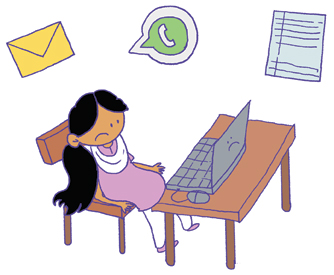Anuradha C
There are several professions in the modern world where the work life and personal life of an individual can be kept reasonably isolated. Bankers, government staffers, lawyers, auditors, engineers (not the IT ones!), the list is quite exhaustive. Out of sight could indeed be out of mind. If there was extra work to be done, companies would pay overtime, because they were encroaching into an individual’s personal time.
Until the pandemic descended upon us, this was largely applicable to teachers too. You would still see the odd teacher bring work home, for correcting examination answer scripts of students, or preparing notes for the upcoming classes. But a good, diligent teacher could well and truly shut out work from their personal lives.
In fact, being a teacher was considered to be a suitable profession for young girls of marriageable age, for precisely this reason. Many a prospective groom would be advised – “Don’t marry a doctor, she’ll have to get to work at odd times. Marry a teacher instead, that’s a safe, tension free job with limited working hours!”
There was also a reverent quality associated with the role of a teacher. Our Indian tradition placed the teacher on a pedestal, next only to a parent. Now, it is being treated as ‘teaching services rendered for fees paid’, just like any other employment. It’s not about humbly requesting your teacher to impart precious knowledge anymore. It’s simply a case of demanding their teaching services as a right!
The pandemic effect
The rude jolt delivered by the pandemic has totally devastated the normal working rhythm of school education across the world. No physical classes, no practical lab sessions, no sports, no extra curriculars, no in-person examinations, no personal contact with the students, I could go on with the list of NOs! Teachers have had to scramble and manage the transition to online mode at record speed. Notwithstanding the fact that many teachers weren’t tech savvy at all, in the first place!

Another disturbing impact of the COVID related disruptions is the reduction of salaries for many teachers in private schools. The justification given by school managements was that some components of the school fees are being waived off for students, hence the reduced cash inflow. The move was further justified saying teachers now save on travel costs and can work at their convenience from home. The Ed-Tech boom also caught up in parallel around the same time, again fuelled by the pandemic. So, several teachers are taking up additional employment as online instructors for these Ed-Tech courses, primarily to offset the income loss.
The entire universe of schooling and education would have descended into calamity and chaos due to the pandemic, if not for one thing – the digital revolution, which has invaded every profession, teaching and education being no exception. Digital devices coupled with cheap internet connectivity have managed to make online classrooms and virtual schools a reality.
Now let’s try and string all these phenomena discussed above into a coherent situation and see how it has collectively impacted the humble teacher.
To put it succinctly, teachers are now a harassed lot! They are earning less but working more; teaching less but talking more; enjoying their job less, just enduring it more.
Teachers are on “Always-ON” mode
The first requirement for setting up remote learning sessions is for teachers and students to share their email ids and phone numbers. If a teacher teaches three different sections and each section has 30-40 pupils, just do the math! You can imagine the explosion in the number of new contacts the teacher has to deal with. And that’s only the students part.
In the earlier days, parents would visit the school for parent-teacher meetings at regular intervals and the teacher would share quality constructive feedback about their pupils, face-to-face. This also helped to build a rapport with the parents. Now, concerned parents just bombard teachers with emails, WhatsApp messages and calls. Being easily accessible through gadgets means being Always-ON. So the teacher’s phone beeps at all odd hours. Sometimes it’s about important things, but mostly it’s about things that can wait.
According to a teacher’s survey conducted by UNESCO in 2021, one of the most critical issues the respondents faced during the COVID-19 pandemic was a drastic increase in working hours. Teachers who were earlier working for 6 to 8 hours a day were now spending roughly 12 hours teaching online, preparing resources, grading assignments and more.”Our working day is no longer fixed from 7:30am to 2:30pm. Now, we start working right from 5am until 11pm, correcting papers, attending unending and often aimlessly organized meetings, often conducted outside of regular working hours. It’s a mess managing our homes while working at these hours,” said one of the respondents, teaching in Maharashtra for over a decade. Despite working for these additional hours, none of the respondents had received extra compensation from their schools. Instead, over half the respondents faced salary cuts during the pandemic. While some encountered minor salary cuts of 10-15 per cent, other respondents experienced significant reductions of about 70 per cent for extensive periods.
(Source: https://paycheck.in/salary/news/teachers-the-forgotten-victims-of-the-covid-19-pandemic)

The right to disconnect?
There is no central law on stipulated working hours for teachers in India. However, some states have enacted regulations, Maharashtra being a good example. According to the Maharashtra Employees of Private Schools (Conditions of Service) Regulation Act, 1977, a full-time teacher should be present during the school’s working hours for a maximum of 30 hours a week. However, there is no regulation in any country yet to monitor or curtail working hours while working remotely.
Also, teachers (especially in private schools) do not have a strong collective voice through organized unions or coordination groups. This makes fighting for a cause even tougher, however just it might be.
So, do teachers have a right to disconnect? Can they refuse to attend a parent’s call after working hours or insist on keeping their weekends free? That’s a question that doesn’t have clear answers as yet. If the teacher is reputed, skilled and has a secure job, certainly yes. But more often than not, private school teachers are hanging onto their jobs by a thread. They cannot afford to be punctilious in the matter of working hours.
Practical solutions to disconnect from work
The next best thing to disconnecting by right is to smartly compartmentalize one’s work and personal lives. A tiny tot student is expected to switch instantaneously from mathematics to history to biology at the ring of a bell, every hour. We teachers can do it too, switch seamlessly between work and home. There are some effective methods and tools that can help in isolating work-related communication and your workspace, keep them away from your personal life.
The key here is to choose your channel of communication wisely. A teacher would need to establish online communication with the class of students for various purposes:
• To share teaching course content, reference links, video teaching sessions.
• To discuss, assign and evaluate assignments, tests and examinations.
• To handle attendance, leave requests, pending works.
• To interact with parents for overall student updates and ensuring the personal well-being of the student.

WhatsApp and emails are not the most effective modes of communication for such one-to-many discussions. Since teachers would be using them for their personal communications too, it would be impossible to segregate work related conversations. There are two ways to resolve this situation.
- Dedicated phone number and email id for work related communication. Most smartphones have dual SIM card facility. Get a separate SIM card for work related communication, share only that number with school contacts. Create a separate email id for work if your school already doesn’t have work related email ids configured. Smart phones have DO-NOT-DISTURB settings, you can designate certain hours of the day or certain days of the week as “NOT AVAILABLE”. The email, WhatsApp notifications will be turned off during this time. So that you can check them later, at your own convenience.
- Non-intrusive, asynchronous communication tools such as Slack, Google classroom. Slack is a communication tool that allows multiple threads of conversation to take place between members at the same instant. So you can establish separate channels such as “Attendance”, “Class Test Feb 2022”, “Science Quiz”, “8th Std Maths” and carry on discussions on each of these threads simultaneously. This helps in recovering information easily when you need it for reference later. It also keeps your email and WhatsApp free for personal things. Google classroom is a virtual classroom which every teacher can create and invite relevant students to participate. It allows you to upload class videos or notes, hold group discussions, conduct tests, monitor attendance and a whole host of other features. Effective use of such tools minimize a lot of overheads during your interactions with students and parents. You can even hold live webinars or open sessions on these tools, such as virtual parent-teacher-meetings, it will help minimize adhoc interactions with parents.
The remote learning and hybrid work culture is here to stay, whether we like it or not. And even after the pandemic fades, a large portion of our work is likely to be conducted online, away from school premises. So there’s no point fussing about the lack of boundaries between work and personal lives. Smart planning and good use of technology enabled solutions is the way forward.
The author is an IT industry drop-out after several years of slogging and money-making. She is now working freelance as a corporate technical trainer and content writer. She is hoping to channelize her passion for writing into a satisfying experience for herself and a joyous experience for her readers. She can be reached at anuradhac@gmail.com.
Related Article
